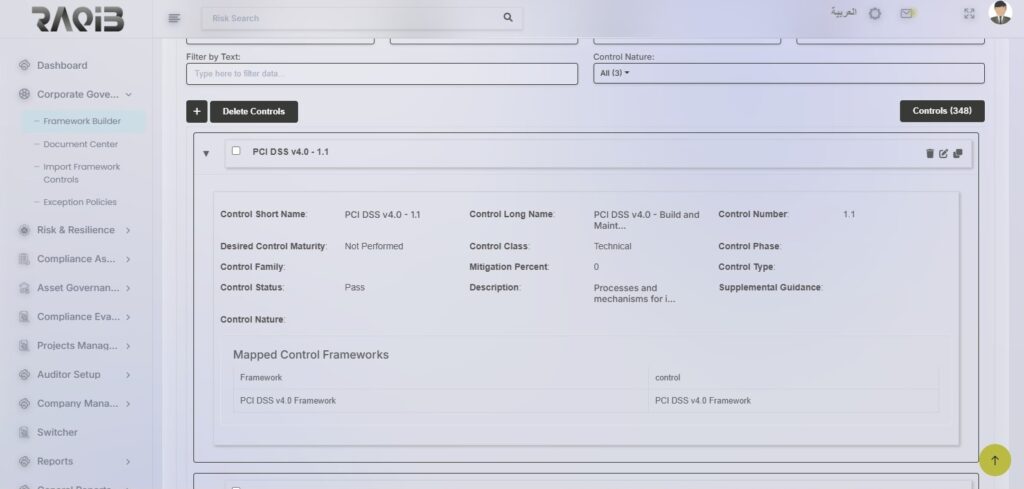
Raqib Framework Builder
Build and Manage Your Custom Frameworks - Control Details
Key Features:
- Create Custom Frameworks: Build frameworks tailored to your organization's specific needs.
- Import Existing Frameworks: Import frameworks from industry standards or other sources.
- Manage Controls: Add, edit, and delete controls within your frameworks.
- Assign Control Owners: Assign responsibility for each control.
- Track Control Maturity: Monitor the maturity level of each control.
- Generate Reports: Generate detailed reports on framework compliance and performance.
How It Works:
- Create a New Framework: Start by defining the name and scope of your framework.
- Add Controls: Add controls to your framework, specifying their details and requirements.
- Assign Owners: Assign owners to each control to ensure accountability.
- Track Progress: Monitor the progress of control implementation and maturity.
- Generate Reports: Generate reports to track compliance and identify areas for improvement.
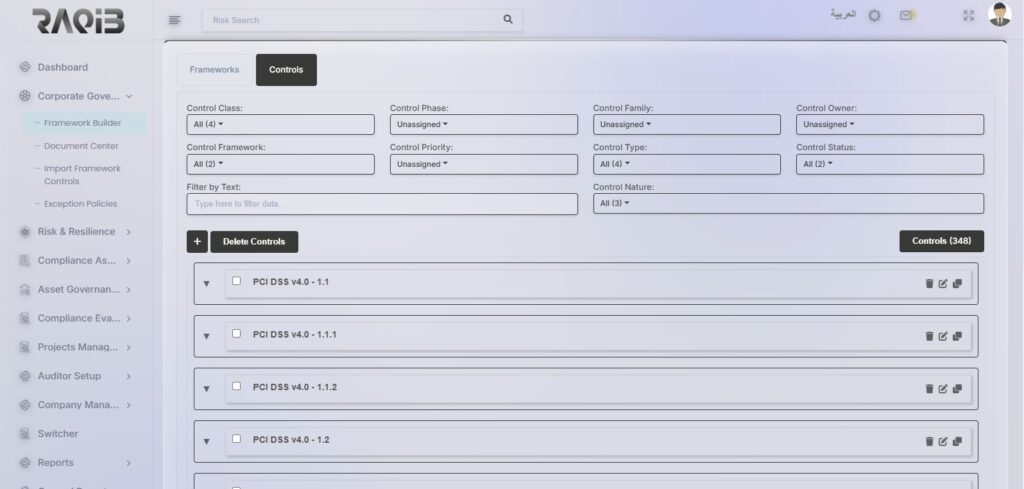
Raqib Framework Builder
Build and Manage Your Custom Frameworks - Controls
Key Features:
- Create Custom Frameworks: Build frameworks tailored to your organization's specific needs.
- Import Existing Frameworks: Import frameworks from industry standards or other sources.
- Manage Controls: Add, edit, and delete controls within your frameworks.
- Assign Control Owners: Assign responsibility for each control.
- Track Control Maturity: Monitor the maturity level of each control.
- Generate Reports: Generate detailed reports on framework compliance and performance.
How It Works:
- Create a New Framework: Start by defining the name and scope of your framework.
- Add Controls: Add controls to your framework, specifying their details and requirements.
- Assign Owners: Assign owners to each control to ensure accountability.
- Track Progress: Monitor the progress of control implementation and maturity.
- Generate Reports: Generate reports to track compliance and identify areas for improvement.
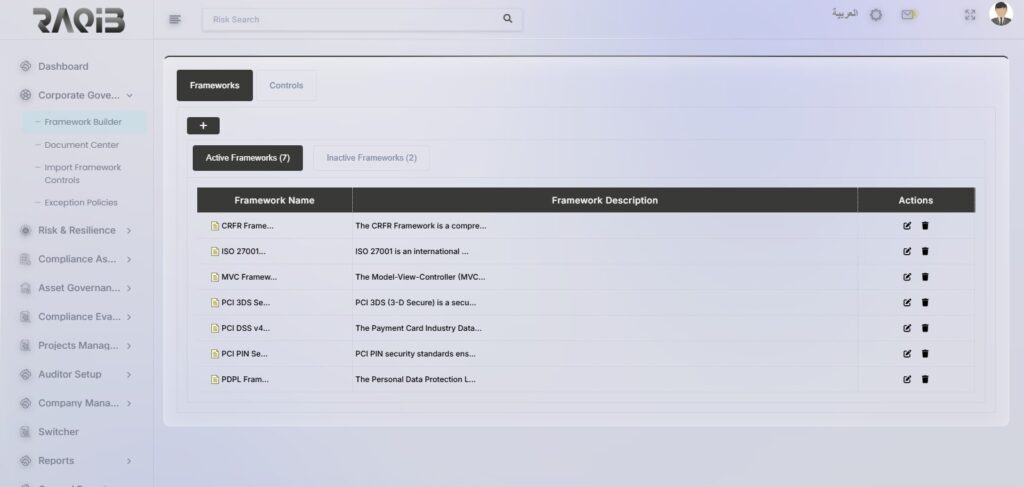
Raqib Framework Builder
Build and Manage Your Custom Frameworks - Frameworks
Key Features:
- Create Custom Frameworks: Build frameworks tailored to your organization's specific needs.
- Import Existing Frameworks: Import frameworks from industry standards or other sources.
- Manage Controls: Add, edit, and delete controls within your frameworks.
- Assign Control Owners: Assign responsibility for each control.
- Track Control Maturity: Monitor the maturity level of each control.
- Generate Reports: Generate detailed reports on framework compliance and performance.
How It Works:
- Create a New Framework: Start by defining the name and scope of your framework.
- Add Controls: Add controls to your framework, specifying their details and requirements.
- Assign Owners: Assign owners to each control to ensure accountability.
- Track Progress: Monitor the progress of control implementation and maturity.
- Generate Reports: Generate reports to track compliance and identify areas for improvement.
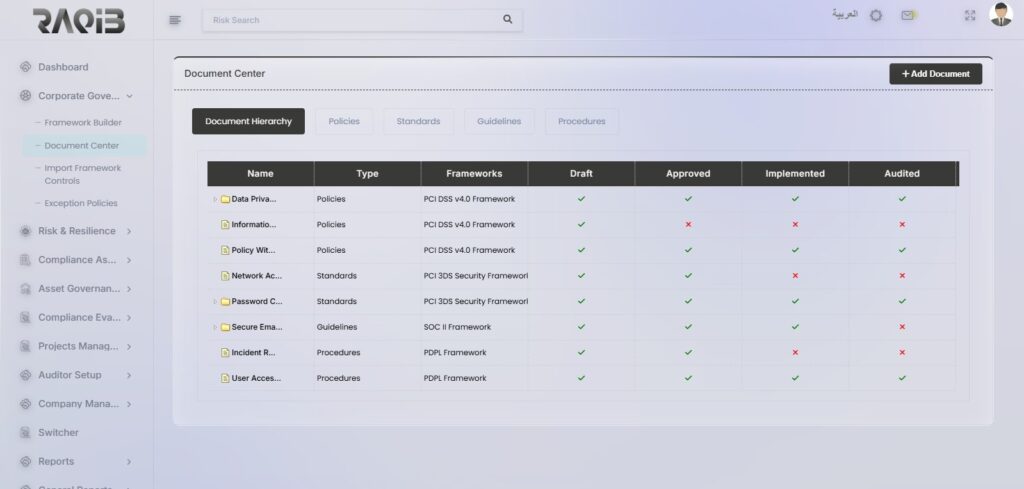
Raqib Document Center
Centralized Repository for Your Organization's Documents
Key Features:
- Document Hierarchy: Organize documents into a hierarchical structure for easy navigation.
- Document Types: Support various document types like policies, standards, guidelines, and procedures.
- Framework Linking: Link documents to specific frameworks for better context.
- Document Lifecycle Management: Track the lifecycle of documents from creation to retirement.
- Version Control: Manage multiple versions of documents and track changes.
- Document Search: Quickly search for documents by keyword, type, or framework.
How It Works:
- Add a New Document: Upload your document and provide relevant metadata.
- Classify Document: Assign the document to the appropriate category (policy, standard, guideline, or procedure).
- Link to Framework: Connect the document to the relevant framework.
- Track Document Status: Monitor the document's status (draft, approved, implemented, audited).
- Manage Versions: Create new versions of documents as needed.
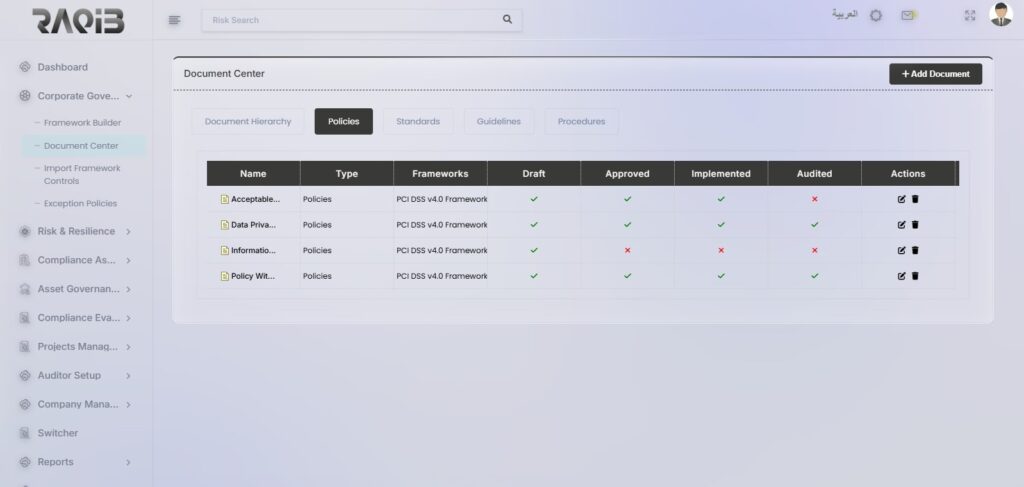
Raqib Document Center
Centralized Repository for Your Organization's Documents
Key Features:
- Document Hierarchy: Organize documents into a hierarchical structure for easy navigation.
- Document Types: Support various document types like policies, standards, guidelines, and procedures.
- Framework Linking: Link documents to specific frameworks for better context.
- Document Lifecycle Management: Track the lifecycle of documents from creation to retirement.
- Version Control: Manage multiple versions of documents and track changes.
- Document Search: Quickly search for documents by keyword, type, or framework.
How It Works:
- Add a New Document: Upload your document and provide relevant metadata.
- Classify Document: Assign the document to the appropriate category (policy, standard, guideline, or procedure).
- Link to Framework: Connect the document to the relevant framework.
- Track Document Status: Monitor the document's status (draft, approved, implemented, audited).
- Manage Versions: Create new versions of documents as needed.
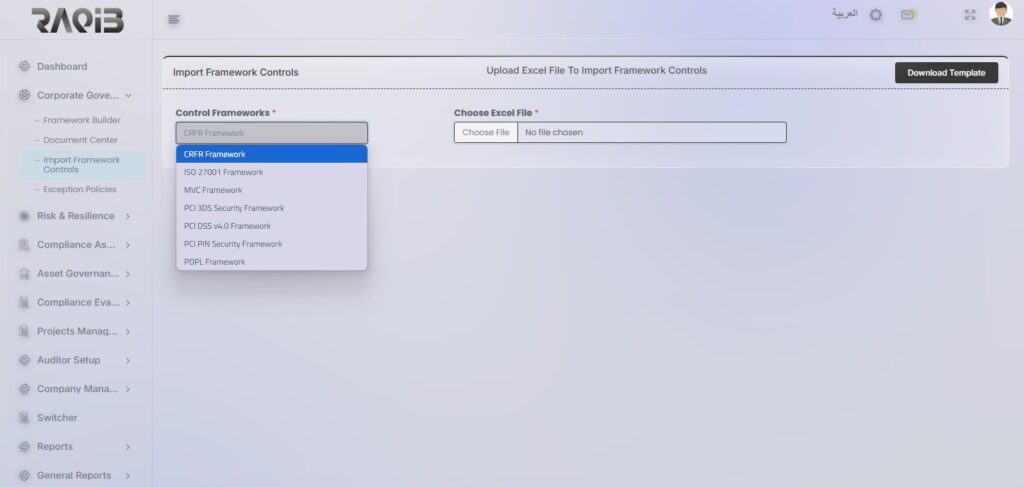
Raqib Import Framework Controls
Streamline Your Framework Management
Key Features:
- Import Excel Files: Easily import controls from Excel files into your frameworks.
- Download Template: Access a pre-formatted template to ensure accurate data entry.
- Choose Framework: Select the target framework for imported controls.
- Multiple Framework Support: Import controls into various frameworks.
- Efficient Control Management: Streamline the process of adding and updating controls.
How It Works:
- Prepare Your Excel File: Use the provided template to organize your control data.
- Upload Your File: Select your Excel file and choose the target framework.
- Import Controls: The system will import the controls, mapping them to the appropriate fields.
- Review and Edit: Review the imported controls and make any necessary adjustments.
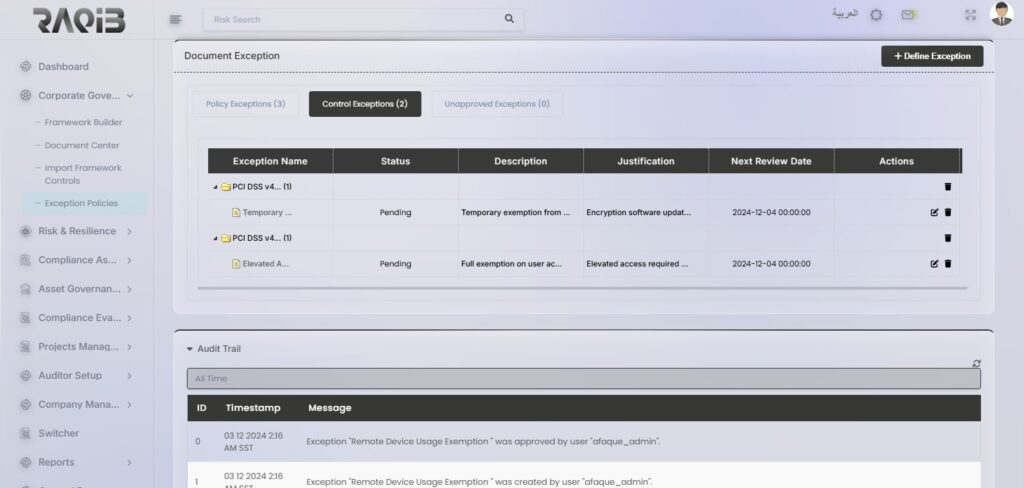
Raqib Exception Policies
Manage and Monitor Exceptions to Your Policies and Controls
Key Features:
- Define Exceptions: Create and manage exceptions to your policies and controls.
- Track Exception Status: Monitor the status of each exception (pending, approved, denied).
- Review and Approve Exceptions: Review and approve or deny exception requests.
- Justify Exceptions: Require justification for each exception to ensure proper oversight.
- Set Expiration Dates: Set expiration dates for temporary exceptions.
- Audit Trail: Track the history of exceptions, including who created and modified them.
How It Works:
- Define Exception: Create a new exception, specifying the policy or control, the reason for the exception, and the required justification.
- Review and Approve: Review the exception request and either approve or deny it.
- Monitor Exception Status: Track the status of the exception and its expiration date.
- Review Audit Trail: View the history of the exception, including any changes or approvals.
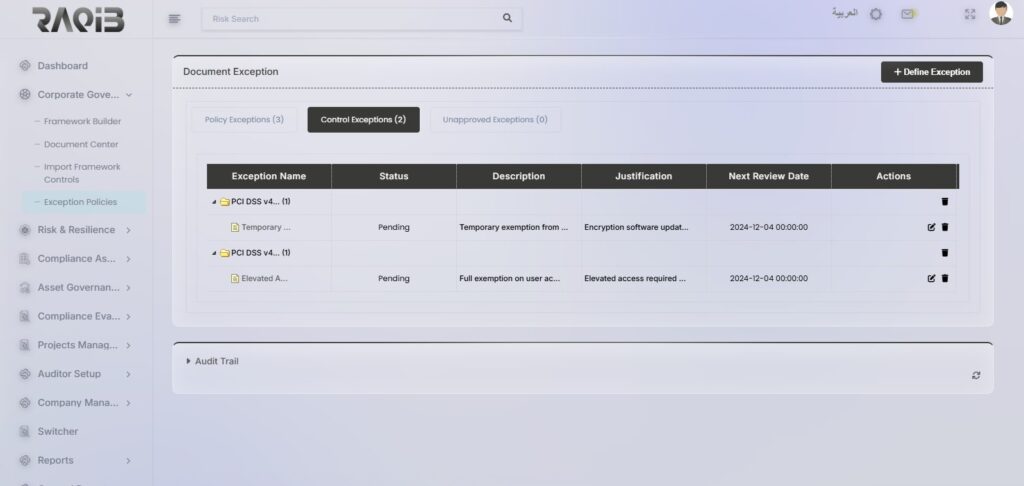
Raqib Exception Policies
Manage and Monitor Exceptions to Your Policies and Controls
Key Features:
- Define Exceptions: Create and manage exceptions to your policies and controls.
- Track Exception Status: Monitor the status of each exception (pending, approved, denied).
- Review and Approve Exceptions: Review and approve or deny exception requests.
- Justify Exceptions: Require justification for each exception to ensure proper oversight.
- Set Expiration Dates: Set expiration dates for temporary exceptions.
- Audit Trail: Track the history of exceptions, including who created and modified them.
How It Works:
- Define Exception: Create a new exception, specifying the policy or control, the reason for the exception, and the required justification.
- Review and Approve: Review the exception request and either approve or deny it.
- Monitor Exception Status: Track the status of the exception and its expiration date.
- Review Audit Trail: View the history of the exception, including any changes or approvals.
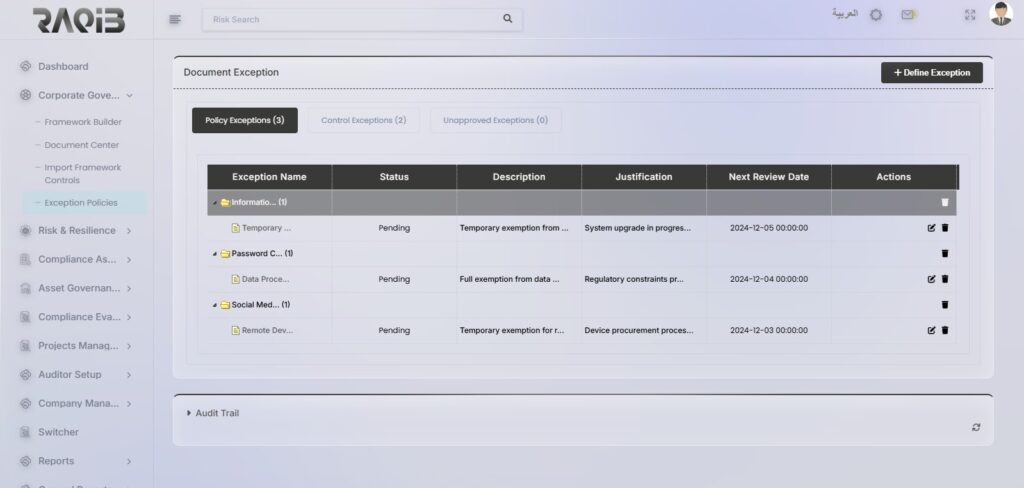
Raqib Exception Policies
Manage and Monitor Exceptions to Your Policies and Controls
Key Features:
- Define Exceptions: Create and manage exceptions to your policies and controls.
- Track Exception Status: Monitor the status of each exception (pending, approved, denied).
- Review and Approve Exceptions: Review and approve or deny exception requests.
- Justify Exceptions: Require justification for each exception to ensure proper oversight.
- Set Expiration Dates: Set expiration dates for temporary exceptions.
- Audit Trail: Track the history of exceptions, including who created and modified them.
How It Works:
- Define Exception: Create a new exception, specifying the policy or control, the reason for the exception, and the required justification.
- Review and Approve: Review the exception request and either approve or deny it.
- Monitor Exception Status: Track the status of the exception and its expiration date.
- Review Audit Trail: View the history of the exception, including any changes or approvals.
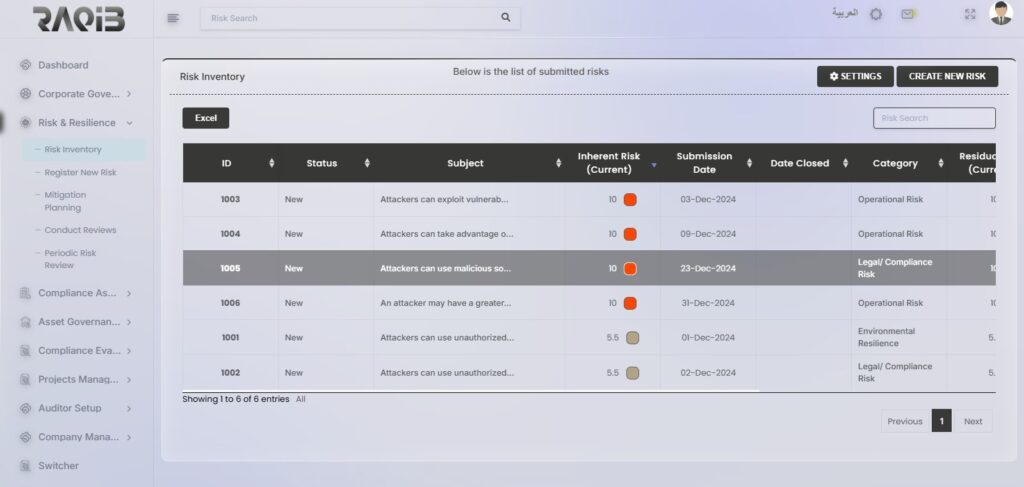
Raqib Risk Inventory
Centralized Repository for Your Organization's Risks
Key Features:
- Risk Registration: Easily register new risks with detailed information.
- Risk Categorization: Categorize risks based on their nature (operational, financial, etc.).
- Risk Assessment: Assess the inherent and residual risk levels for each risk.
- Risk Tracking: Track the status of each risk (new, open, closed, mitigated).
- Risk Prioritization: Prioritize risks based on their impact and likelihood.
- Risk Mitigation Planning: Develop and track mitigation plans for identified risks.
How It Works:
- Register a New Risk: Create a new risk record, providing details about the risk, its potential impact, and its likelihood.
- Assess Risk: Evaluate the inherent and residual risk levels using appropriate risk assessment methodologies.
- Prioritize Risk: Assign a priority level to the risk based on its impact and likelihood.
- Develop Mitigation Plan: Create a mitigation plan to address the risk and reduce its impact.
- Track Risk Status: Monitor the status of the risk and its associated mitigation plan.
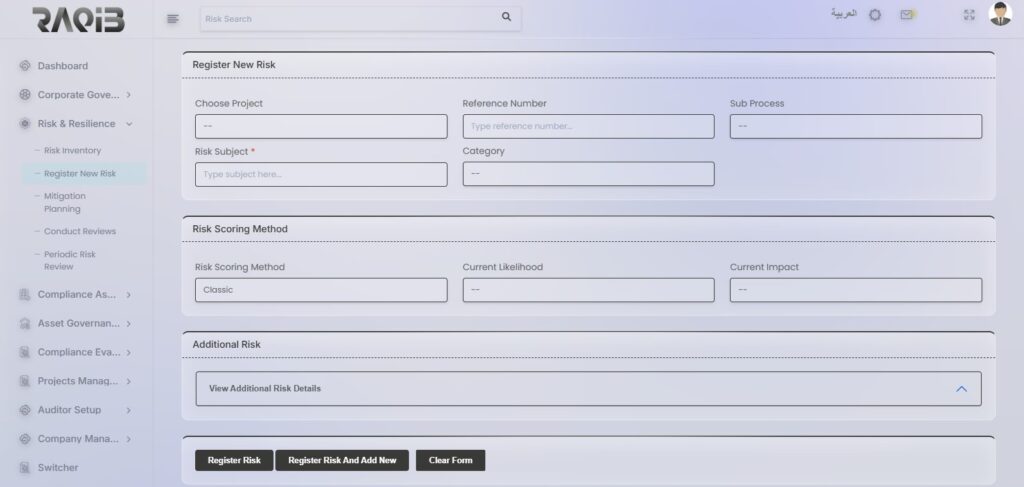
Raqib Risk Register
Centralized Repository for Your Organization's Risks
Key Features:
- Risk Registration: Easily register new risks with detailed information.
- Risk Categorization: Categorize risks based on their nature (operational, financial, etc.).
- Risk Assessment: Assess the inherent and residual risk levels for each risk.
- Risk Tracking: Track the status of each risk (new, open, closed, mitigated).
- Risk Prioritization: Prioritize risks based on their impact and likelihood.
- Risk Mitigation Planning: Develop and track mitigation plans for identified risks.
How It Works:
- Register a New Risk: Create a new risk record, providing details about the risk, its potential impact, and its likelihood.
- Assess Risk: Evaluate the inherent and residual risk levels using appropriate risk assessment methodologies.
- Prioritize Risk: Assign a priority level to the risk based on its impact and likelihood.
- Develop Mitigation Plan: Create a mitigation plan to address the risk and reduce its impact.
- Track Risk Status: Monitor the status of the risk and its associated mitigation plan.
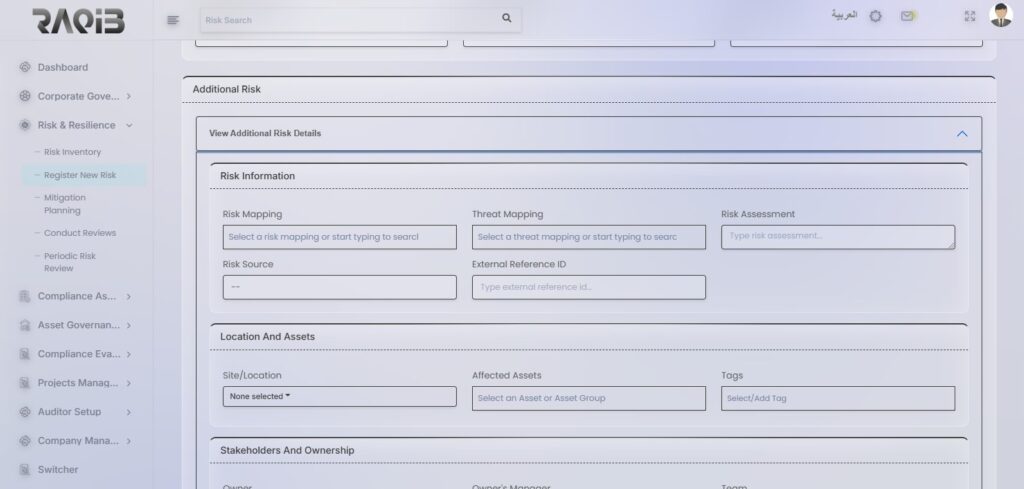
Raqib Risk Register
Centralized Repository for Your Organization's Risks
Key Features:
- Risk Registration: Easily register new risks with detailed information.
- Risk Categorization: Categorize risks based on their nature (operational, financial, etc.).
- Risk Assessment: Assess the inherent and residual risk levels for each risk.
- Risk Tracking: Track the status of each risk (new, open, closed, mitigated).
- Risk Prioritization: Prioritize risks based on their impact and likelihood.
- Risk Mitigation Planning: Develop and track mitigation plans for identified risks.
How It Works:
- Register a New Risk: Create a new risk record, providing details about the risk, its potential impact, and its likelihood.
- Assess Risk: Evaluate the inherent and residual risk levels using appropriate risk assessment methodologies.
- Prioritize Risk: Assign a priority level to the risk based on its impact and likelihood.
- Develop Mitigation Plan: Create a mitigation plan to address the risk and reduce its impact.
- Track Risk Status: Monitor the status of the risk and its associated mitigation plan.
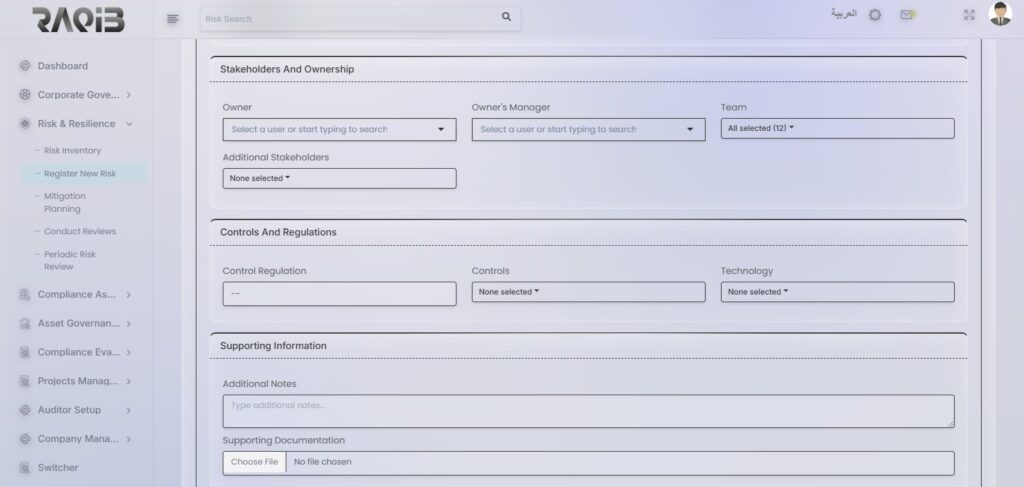
Raqib Risk Register
Centralized Repository for Your Organization's Risks
Key Features:
- Risk Registration: Easily register new risks with detailed information.
- Risk Categorization: Categorize risks based on their nature (operational, financial, etc.).
- Risk Assessment: Assess the inherent and residual risk levels for each risk.
- Risk Tracking: Track the status of each risk (new, open, closed, mitigated).
- Risk Prioritization: Prioritize risks based on their impact and likelihood.
- Risk Mitigation Planning: Develop and track mitigation plans for identified risks.
How It Works:
- Register a New Risk: Create a new risk record, providing details about the risk, its potential impact, and its likelihood.
- Assess Risk: Evaluate the inherent and residual risk levels using appropriate risk assessment methodologies.
- Prioritize Risk: Assign a priority level to the risk based on its impact and likelihood.
- Develop Mitigation Plan: Create a mitigation plan to address the risk and reduce its impact.
- Track Risk Status: Monitor the status of the risk and its associated mitigation plan.
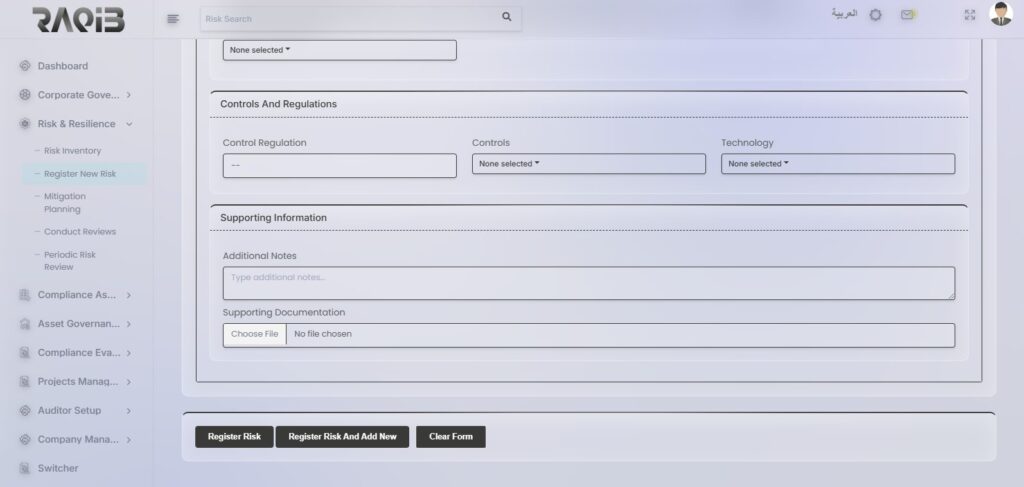
Raqib Risk Register
Centralized Repository for Your Organization's Risks
Key Features:
- Risk Registration: Easily register new risks with detailed information.
- Risk Categorization: Categorize risks based on their nature (operational, financial, etc.).
- Risk Assessment: Assess the inherent and residual risk levels for each risk.
- Risk Tracking: Track the status of each risk (new, open, closed, mitigated).
- Risk Prioritization: Prioritize risks based on their impact and likelihood.
- Risk Mitigation Planning: Develop and track mitigation plans for identified risks.
How It Works:
- Register a New Risk: Create a new risk record, providing details about the risk, its potential impact, and its likelihood.
- Assess Risk: Evaluate the inherent and residual risk levels using appropriate risk assessment methodologies.
- Prioritize Risk: Assign a priority level to the risk based on its impact and likelihood.
- Develop Mitigation Plan: Create a mitigation plan to address the risk and reduce its impact.
- Track Risk Status: Monitor the status of the risk and its associated mitigation plan.

Raqib Risk Register
Centralized Repository for Your Organization's Risks
Key Features:
- Risk Registration: Easily register new risks with detailed information.
- Risk Categorization: Categorize risks based on their nature (operational, financial, etc.).
- Risk Assessment: Assess the inherent and residual risk levels for each risk.
- Risk Tracking: Track the status of each risk (new, open, closed, mitigated).
- Risk Prioritization: Prioritize risks based on their impact and likelihood.
- Risk Mitigation Planning: Develop and track mitigation plans for identified risks.
How It Works:
- Register a New Risk: Create a new risk record, providing details about the risk, its potential impact, and its likelihood.
- Assess Risk: Evaluate the inherent and residual risk levels using appropriate risk assessment methodologies.
- Prioritize Risk: Assign a priority level to the risk based on its impact and likelihood.
- Develop Mitigation Plan: Create a mitigation plan to address the risk and reduce its impact.
- Track Risk Status: Monitor the status of the risk and its associated mitigation plan.
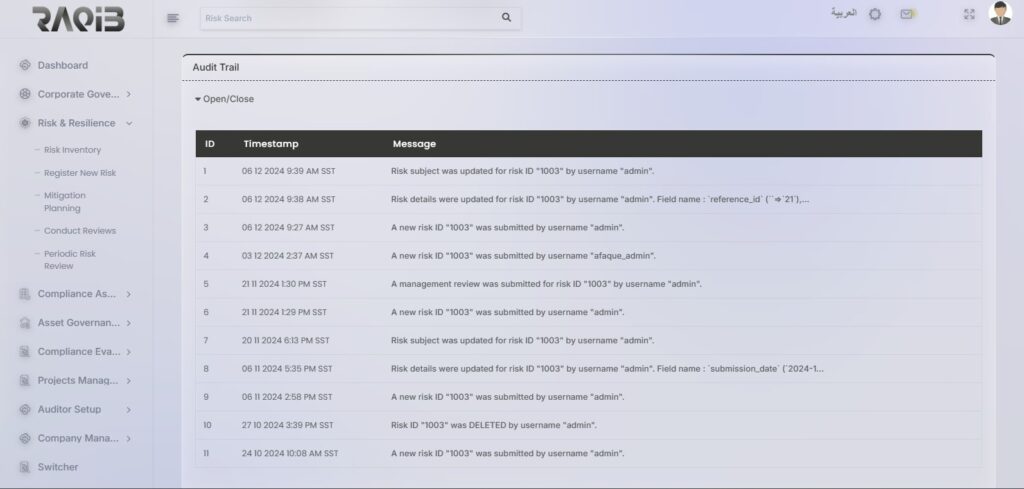
Raqib Risk Register
Centralized Repository for Your Organization's Risks
Key Features:
- Risk Registration: Easily register new risks with detailed information.
- Risk Categorization: Categorize risks based on their nature (operational, financial, etc.).
- Risk Assessment: Assess the inherent and residual risk levels for each risk.
- Risk Tracking: Track the status of each risk (new, open, closed, mitigated).
- Risk Prioritization: Prioritize risks based on their impact and likelihood.
- Risk Mitigation Planning: Develop and track mitigation plans for identified risks.
How It Works:
- Register a New Risk: Create a new risk record, providing details about the risk, its potential impact, and its likelihood.
- Assess Risk: Evaluate the inherent and residual risk levels using appropriate risk assessment methodologies.
- Prioritize Risk: Assign a priority level to the risk based on its impact and likelihood.
- Develop Mitigation Plan: Create a mitigation plan to address the risk and reduce its impact.
- Track Risk Status: Monitor the status of the risk and its associated mitigation plan.
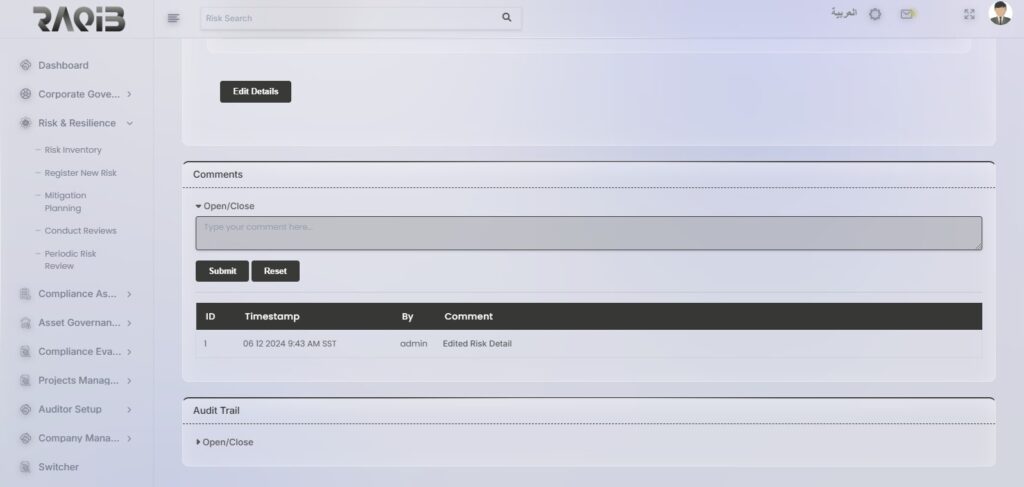
Raqib Risk Register
Centralized Repository for Your Organization's Risks
Key Features:
- Risk Registration: Easily register new risks with detailed information.
- Risk Categorization: Categorize risks based on their nature (operational, financial, etc.).
- Risk Assessment: Assess the inherent and residual risk levels for each risk.
- Risk Tracking: Track the status of each risk (new, open, closed, mitigated).
- Risk Prioritization: Prioritize risks based on their impact and likelihood.
- Risk Mitigation Planning: Develop and track mitigation plans for identified risks.
- Collaboration and Comments: Facilitate collaboration and discussion among stakeholders through comments.
- Audit Trail: Track the history of changes and updates to the risk record.
How It Works:
- Register a New Risk: Create a new risk record, providing details about the risk, its potential impact, and its likelihood.
- Assess Risk: Evaluate the inherent and residual risk levels using appropriate risk assessment methodologies.
- Prioritize Risk: Assign a priority level to the risk based on its impact and likelihood.
- Develop Mitigation Plan: Create a mitigation plan to address the risk and reduce its impact.
- Track Risk Status: Monitor the status of the risk and its associated mitigation plan.
- Collaborate and Comment: Add comments to the risk record to discuss and share insights.
- Review Audit Trail: Track the history of changes and updates to the risk record.
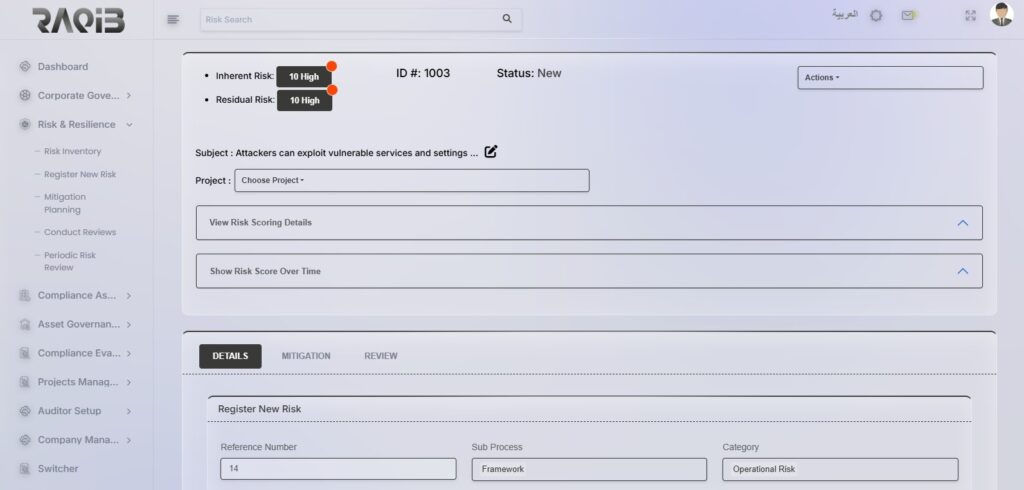
Raqib Risk Register
Centralized Repository for Your Organization's Risks
Key Features:
- Risk Registration: Easily register new risks with detailed information.
- Risk Categorization: Categorize risks based on their nature (operational, financial, etc.).
- Risk Assessment: Assess the inherent and residual risk levels for each risk.
- Risk Tracking: Track the status of each risk (new, open, closed, mitigated).
- Risk Prioritization: Prioritize risks based on their impact and likelihood.
- Risk Mitigation Planning: Develop and track mitigation plans for identified risks.
- Collaboration and Comments: Facilitate collaboration and discussion among stakeholders through comments.
- Audit Trail: Track the history of changes and updates to the risk record.
How It Works:
- Register a New Risk: Create a new risk record, providing details about the risk, its potential impact, and its likelihood.
- Assess Risk: Evaluate the inherent and residual risk levels using appropriate risk assessment methodologies.
- Prioritize Risk: Assign a priority level to the risk based on its impact and likelihood.
- Develop Mitigation Plan: Create a mitigation plan to address the risk and reduce its impact.
- Track Risk Status: Monitor the status of the risk and its associated mitigation plan.
- Collaborate and Comment: Add comments to the risk record to discuss and share insights.
- Review Audit Trail: Track the history of changes and updates to the risk record.
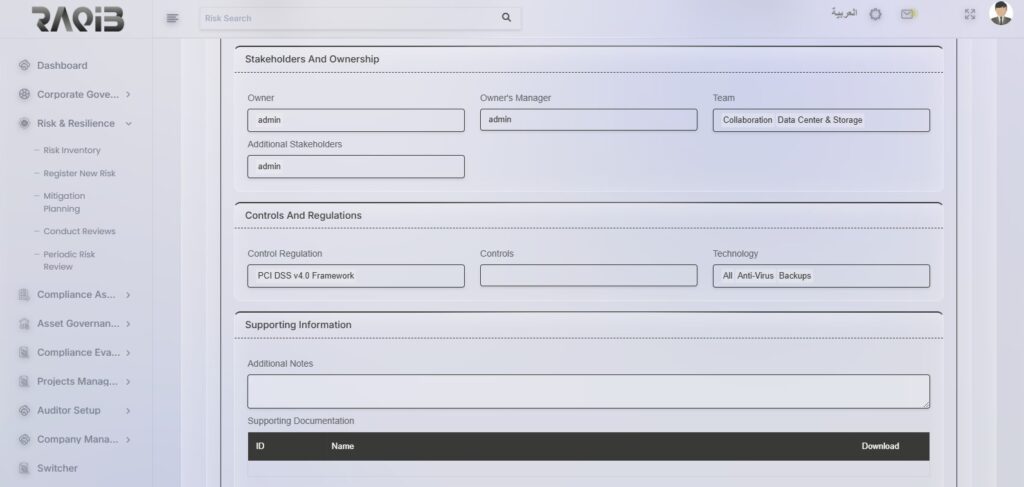
Raqib Risk Register
Centralized Repository for Your Organization's Risks
Key Features:
- Risk Registration: Easily register new risks with detailed information.
- Risk Categorization: Categorize risks based on their nature (operational, financial, etc.).
- Risk Assessment: Assess the inherent and residual risk levels for each risk.
- Risk Tracking: Track the status of each risk (new, open, closed, mitigated).
- Risk Prioritization: Prioritize risks based on their impact and likelihood.
- Risk Mitigation Planning: Develop and track mitigation plans for identified risks.
- Collaboration and Comments: Facilitate collaboration and discussion among stakeholders through comments.
- Audit Trail: Track the history of changes and updates to the risk record.
- Stakeholder Management: Assign owners, managers, and teams to each risk.
- Control Mapping: Link risks to relevant controls and regulations.
- Supporting Documentation: Attach relevant documentation to each risk.
How It Works:
- Register a New Risk: Create a new risk record, providing details about the risk, its potential impact, and its likelihood.
- Assess Risk: Evaluate the inherent and residual risk levels using appropriate risk assessment methodologies.
- Prioritize Risk: Assign a priority level to the risk based on its impact and likelihood.
- Develop Mitigation Plan: Create a mitigation plan to address the risk and reduce its impact.
- Track Risk Status: Monitor the status of the risk and its associated mitigation plan.
- Collaborate and Comment: Add comments to the risk record to discuss and share insights.
- Review Audit Trail: Track the history of changes and updates to the risk record.
- Assign Ownership: Specify the owner, owner's manager, and team responsible for the risk.
- Map Controls: Link the risk to relevant controls and regulations.
- Attach Documentation: Upload supporting documentation related to the risk.
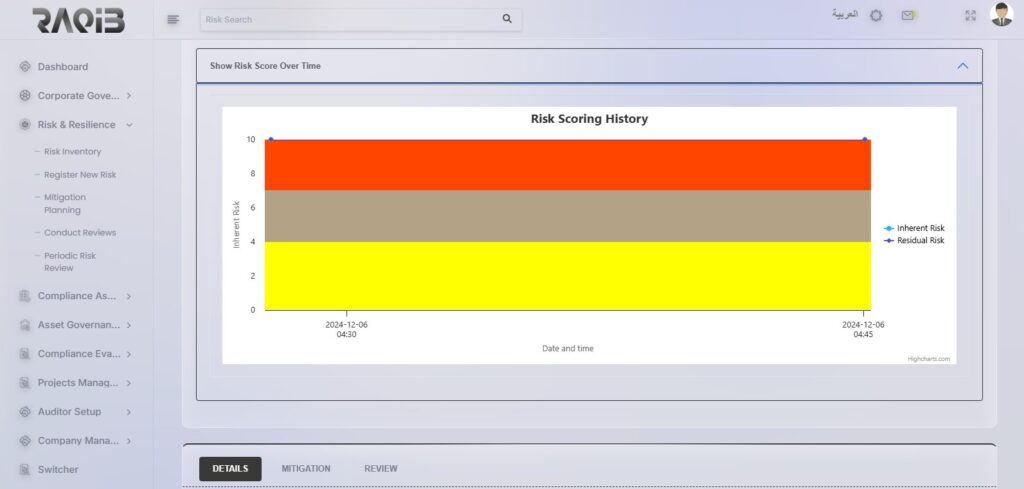
Raqib Risk Register
Centralized Repository for Your Organization's Risks
Key Features:
- Risk Registration: Easily register new risks with detailed information.
- Risk Categorization: Categorize risks based on their nature (operational, financial, etc.).
- Risk Assessment: Assess the inherent and residual risk levels for each risk.
- Risk Tracking: Track the status of each risk (new, open, closed, mitigated).
- Risk Prioritization: Prioritize risks based on their impact and likelihood.
- Risk Mitigation Planning: Develop and track mitigation plans for identified risks.
- Collaboration and Comments: Facilitate collaboration and discussion among stakeholders through comments.
- Audit Trail: Track the history of changes and updates to the risk record.
- Stakeholder Management: Assign owners, managers, and teams to each risk.
- Control Mapping: Link risks to relevant controls and regulations.
- Supporting Documentation: Attach relevant documentation to each risk.
- Risk Scoring History: Visualize the changes in risk scores over time.
How It Works:
- Register a New Risk: Create a new risk record, providing details about the risk, its potential impact, and its likelihood.
- Assess Risk: Evaluate the inherent and residual risk levels using appropriate risk assessment methodologies.
- Prioritize Risk: Assign a priority level to the risk based on its impact and likelihood.
- Develop Mitigation Plan: Create a mitigation plan to address the risk and reduce its impact.
- Track Risk Status: Monitor the status of the risk and its associated mitigation plan.
- Collaborate and Comment: Add comments to the risk record to discuss and share insights.
- Review Audit Trail: Track the history of changes and updates to the risk record.
- Assign Ownership: Specify the owner, owner's manager, and team responsible for the risk.
- Map Controls: Link the risk to relevant controls and regulations.
- Attach Documentation: Upload supporting documentation related to the risk.
- Track Risk Score Changes: View a visual representation of changes in risk scores over time.
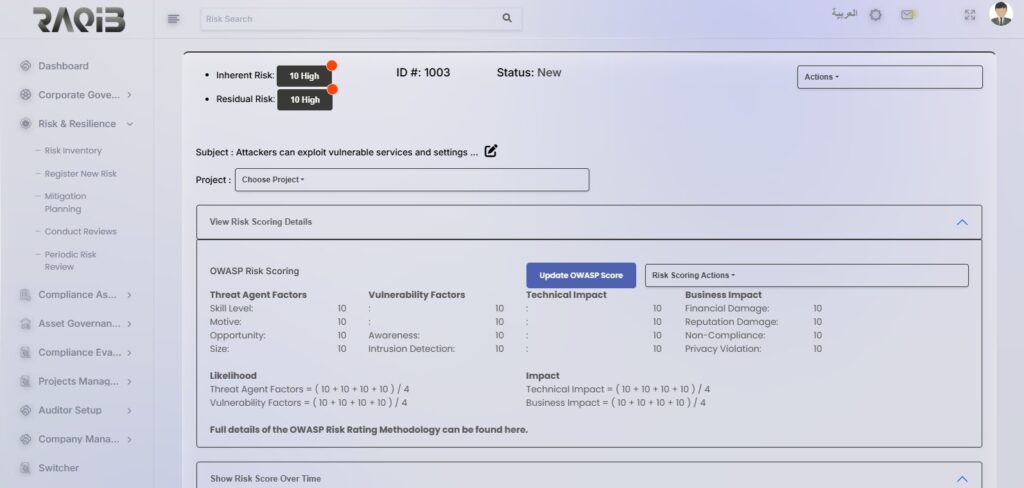
Raqib Risk Register
Centralized Repository for Your Organization's Risks
Key Features:
- Risk Registration: Easily register new risks with detailed information.
- Risk Categorization: Categorize risks based on their nature (operational, financial, etc.).
- Risk Assessment: Assess the inherent and residual risk levels for each risk.
- Risk Tracking: Track the status of each risk (new, open, closed, mitigated).
- Risk Prioritization: Prioritize risks based on their impact and likelihood.
- Risk Mitigation Planning: Develop and track mitigation plans for identified risks.
- Collaboration and Comments: Facilitate collaboration and discussion among stakeholders through comments.
- Audit Trail: Track the history of changes and updates to the risk record.
- Stakeholder Management: Assign owners, managers, and teams to each risk.
- Control Mapping: Link risks to relevant controls and regulations.
- Supporting Documentation: Attach relevant documentation to each risk.
- Risk Scoring History: Visualize the changes in risk scores over time.
- OWASP Risk Scoring: Utilize the OWASP Risk Rating Methodology for detailed risk assessment.
How It Works:
- Register a New Risk: Create a new risk record, providing details about the risk, its potential impact, and its likelihood.
- Assess Risk: Evaluate the inherent and residual risk levels using appropriate risk assessment methodologies, including the OWASP Risk Rating Methodology.
- Prioritize Risk: Assign a priority level to the risk based on its impact and likelihood.
- Develop Mitigation Plan: Create a mitigation plan to address the risk and reduce its impact.
- Track Risk Status: Monitor the status of the risk and its associated mitigation plan.
- Collaborate and Comment: Add comments to the risk record to discuss and share insights.
- Review Audit Trail: Track the history of changes and updates to the risk record.
- Assign Ownership: Specify the owner, owner's manager, and team responsible for the risk.
- Map Controls: Link the risk to relevant controls and regulations.
- Attach Documentation: Upload supporting documentation related to the risk.
- Track Risk Score Changes: View a visual representation of changes in risk scores over time.
- Utilize OWASP Risk Scoring: Leverage the OWASP Risk Rating Methodology to assess risk factors and calculate overall risk scores.
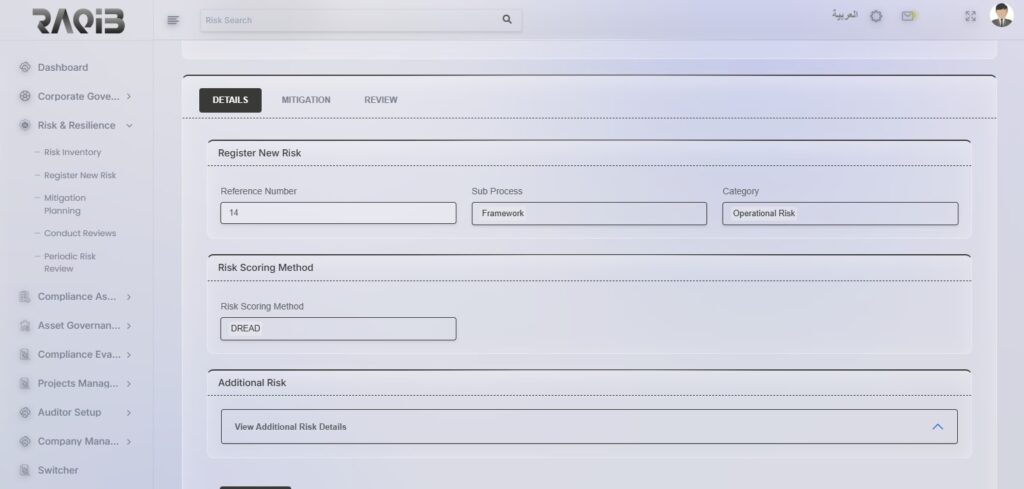
Raqib Risk Register
Centralized Repository for Your Organization's Risks
Key Features:
- Risk Registration: Easily register new risks with detailed information.
- Risk Categorization: Categorize risks based on their nature (operational, financial, etc.).
- Risk Assessment: Assess the inherent and residual risk levels for each risk.
- Risk Tracking: Track the status of each risk (new, open, closed, mitigated).
- Risk Prioritization: Prioritize risks based on their impact and likelihood.
- Risk Mitigation Planning: Develop and track mitigation plans for identified risks.
- Collaboration and Comments: Facilitate collaboration and discussion among stakeholders through comments.
- Audit Trail: Track the history of changes and updates to the risk record.
- Stakeholder Management: Assign owners, managers, and teams to each risk.
- Control Mapping: Link risks to relevant controls and regulations.
- Supporting Documentation: Attach relevant documentation to each risk.
- Risk Scoring History: Visualize the changes in risk scores over time.
- OWASP Risk Scoring: Utilize the OWASP Risk Rating Methodology for detailed risk assessment.
- DREAD Risk Scoring: Utilize the DREAD Risk Rating Methodology for detailed risk assessment.
How It Works:
- Register a New Risk: Create a new risk record, providing details about the risk, its potential impact, and its likelihood.
- Assess Risk: Evaluate the inherent and residual risk levels using appropriate risk assessment methodologies, including the OWASP Risk Rating Methodology and DREAD Risk Rating Methodology.
- Prioritize Risk: Assign a priority level to the risk based on its impact and likelihood.
- Develop Mitigation Plan: Create a mitigation plan to address the risk and reduce its impact.
- Track Risk Status: Monitor the status of the risk and its associated mitigation plan.
- Collaborate and Comment: Add comments to the risk record to discuss and share insights.
- Review Audit Trail: Track the history of changes and updates to the risk record.
- Assign Ownership: Specify the owner, owner's manager, and team responsible for the risk.
- Map Controls: Link the risk to relevant controls and regulations.
- Attach Documentation: Upload supporting documentation related to the risk.
- Track Risk Score Changes: View a visual representation of changes in risk scores over time.
- Utilize OWASP Risk Scoring: Leverage the OWASP Risk Rating Methodology to assess risk factors and calculate overall risk scores.
- Utilize DREAD Risk Scoring: Leverage the DREAD Risk Rating Methodology to assess risk factors and calculate overall risk scores.
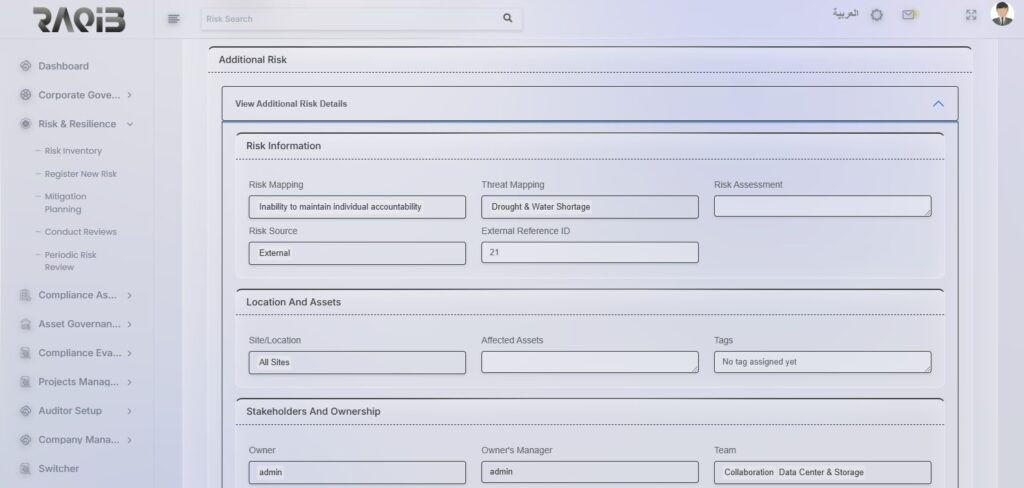
Raqib Risk Register
Centralized Repository for Your Organization's Risks
Key Features:
- Risk Registration: Easily register new risks with detailed information.
- Risk Categorization: Categorize risks based on their nature (operational, financial, etc.).
- Risk Assessment: Assess the inherent and residual risk levels for each risk.
- Risk Tracking: Track the status of each risk (new, open, closed, mitigated).
- Risk Prioritization: Prioritize risks based on their impact and likelihood.
- Risk Mitigation Planning: Develop and track mitigation plans for identified risks.
- Collaboration and Comments: Facilitate collaboration and discussion among stakeholders through comments.
- Audit Trail: Track the history of changes and updates to the risk record.
- Stakeholder Management: Assign owners, managers, and teams to each risk.
- Control Mapping: Link risks to relevant controls and regulations.
- Supporting Documentation: Attach relevant documentation to each risk.
- Risk Scoring History: Visualize the changes in risk scores over time.
- OWASP Risk Scoring: Utilize the OWASP Risk Rating Methodology for detailed risk assessment.
- DREAD Risk Scoring: Utilize the DREAD Risk Rating Methodology for detailed risk assessment.
- Risk Mapping: Map risks to specific threats and vulnerabilities.
How It Works:
- Register a New Risk: Create a new risk record, providing details about the risk, its potential impact, and its likelihood.
- Assess Risk: Evaluate the inherent and residual risk levels using appropriate risk assessment methodologies, including the OWASP Risk Rating Methodology and DREAD Risk Rating Methodology.
- Prioritize Risk: Assign a priority level to the risk based on its impact and likelihood.
- Develop Mitigation Plan: Create a mitigation plan to address the risk and reduce its impact.
- Track Risk Status: Monitor the status of the risk and its associated mitigation plan.
- Collaborate and Comment: Add comments to the risk record to discuss and share insights.
- Review Audit Trail: Track the history of changes and updates to the risk record.
- Assign Ownership: Specify the owner, owner's manager, and team responsible for the risk.
- Map Controls: Link the risk to relevant controls and regulations.
- Attach Documentation: Upload supporting documentation related to the risk.
- Track Risk Score Changes: View a visual representation of changes in risk scores over time.
- Utilize OWASP Risk Scoring: Leverage the OWASP Risk Rating Methodology to assess risk factors and calculate overall risk scores.
- Utilize DREAD Risk Scoring: Leverage the DREAD Risk Rating Methodology to assess risk factors and calculate overall risk scores.
- Map Risks to Threats and Vulnerabilities: Identify the specific threats and vulnerabilities that could lead to the realization of the risk.
